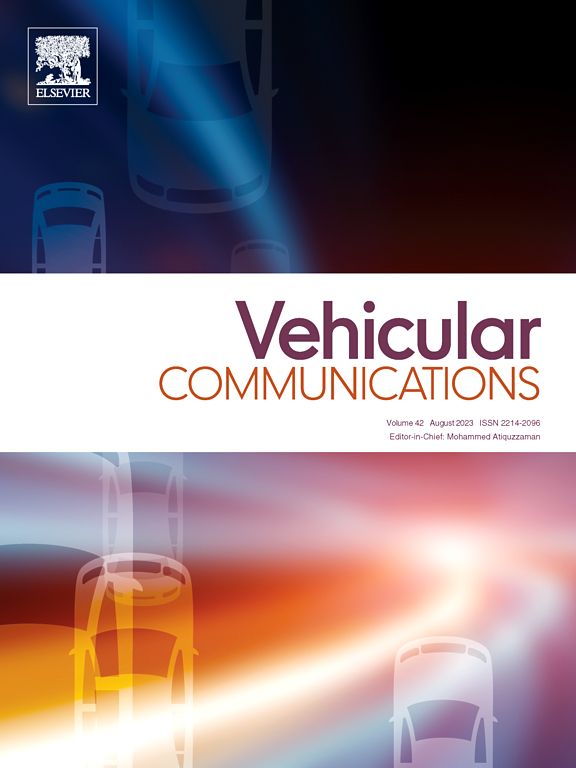支持fanet的基于集群的应急通信,具有5G及以后的3D移动性
IF 6.5
2区 计算机科学
Q1 TELECOMMUNICATIONS
引用次数: 0
摘要
在5G及以后,无人驾驶飞行器(uav)因其通信能力、可负担性和部署灵活性而受到高度重视。多无人机系统,在称为无人机自组织网络或飞行自组织网络(fanet)的自组织网络中操作,代表了当前和未来最有前途的一些技术。在灾害情况下,建立基于无人机的临时应急飞行基站(BSs),在蜂窝网络中提供无线覆盖,建立远程数据传输的通信中继将是至关重要的。要建立这一网络,无人机之间的有效通信是最关键的一点。此外,由于移动性,拓扑结构经常变化,导致潜在的冲突和丢包。为此,本文提出了一种基于最小距离聚类方案(MDCS)的FANET,该方案在考虑基于随机路径的三维机动性模型的基础上,通过计算无人机在三维平台上的相对速度,通过后退机制控制拓扑结构,使无人机在不同高度移动时也能保持网络连通性。介绍了一种有效的簇建立过程和确定簇头(CH)位置的方法,以熟练地控制簇。对Rayleigh、Nakagami-m和rici衰落信道进行了分析研究。此外,得到的蒙特卡罗模拟结果验证了分析结果。最后,在距离、速度、无人机数量变化的吞吐量、中断概率、丢包率和延迟方面,仿真结果优于现有工作。在专家衰落信道的情况下,对于40架无人机,集群大小为7或更少更有利,显示最大连接距离为165米,最大吞吐量为10.2 Mbps,最大延迟为55.57 ms。本文章由计算机程序翻译,如有差异,请以英文原文为准。
FANET-enabled cluster-based emergency communication with 3D mobility in 5G and beyond
In 5G and beyond, unmanned aerial vehicles (UAVs) are highly valued for their communication capabilities, affordability, and deployment flexibility. Multi-UAV systems, which operate in ad-hoc networks known as UAV ad-hoc networks or flying ad-hoc networks (FANETs), represent some of the most promising technologies both currently and in the future. In disaster situations, it will be crucial to set up temporary UAV-based emergency flying base stations (BSs), provide wireless coverage in cellular networks, and establish communication relays for long-distance data transmission. To establish this network, efficient communication between the UAVs is the most vital point. Additionally, due to mobility, the topology changes frequently, leading to potential collisions and packet losses. Therefore, in this paper, a minimum distance clustering scheme (MDCS)-based FANET is proposed, where the topology is controlled by a back-off mechanism and network connectivity is maintained even when the UAVs are moving at different altitudes by calculating the relative velocity on a 3D platform while considering the randomized path-based 3D mobility model. An efficient cluster build-up process and a method for determining the position of the cluster head (CH) are introduced to control the cluster proficiently. An analytical study is performed considering Rayleigh, Nakagami-m, and Rician fading channels. Moreover, the obtained Monte Carlo simulation results justify the analytical findings. Finally, the simulations show better results than existing work in terms of throughput with changes in distance, velocity, and the number of UAVs, as well as outage probability, packet dropping rate, and delay. In the case of the Rician fading channel, for 40 UAVs, a cluster size of 7 or fewer is more favorable, showing a maximum connection distance of 165 m, a maximum throughput of 10.2 Mbps, and a maximum delay of 55.57 ms.
求助全文
通过发布文献求助,成功后即可免费获取论文全文。
去求助
来源期刊

Vehicular Communications
Engineering-Electrical and Electronic Engineering
CiteScore
12.70
自引率
10.40%
发文量
88
审稿时长
62 days
期刊介绍:
Vehicular communications is a growing area of communications between vehicles and including roadside communication infrastructure. Advances in wireless communications are making possible sharing of information through real time communications between vehicles and infrastructure. This has led to applications to increase safety of vehicles and communication between passengers and the Internet. Standardization efforts on vehicular communication are also underway to make vehicular transportation safer, greener and easier.
The aim of the journal is to publish high quality peer–reviewed papers in the area of vehicular communications. The scope encompasses all types of communications involving vehicles, including vehicle–to–vehicle and vehicle–to–infrastructure. The scope includes (but not limited to) the following topics related to vehicular communications:
Vehicle to vehicle and vehicle to infrastructure communications
Channel modelling, modulating and coding
Congestion Control and scalability issues
Protocol design, testing and verification
Routing in vehicular networks
Security issues and countermeasures
Deployment and field testing
Reducing energy consumption and enhancing safety of vehicles
Wireless in–car networks
Data collection and dissemination methods
Mobility and handover issues
Safety and driver assistance applications
UAV
Underwater communications
Autonomous cooperative driving
Social networks
Internet of vehicles
Standardization of protocols.
 求助内容:
求助内容: 应助结果提醒方式:
应助结果提醒方式:


